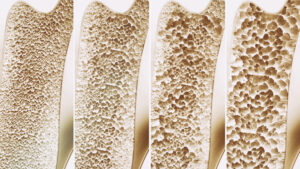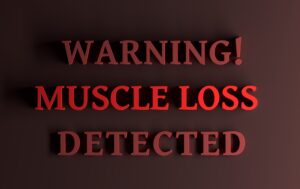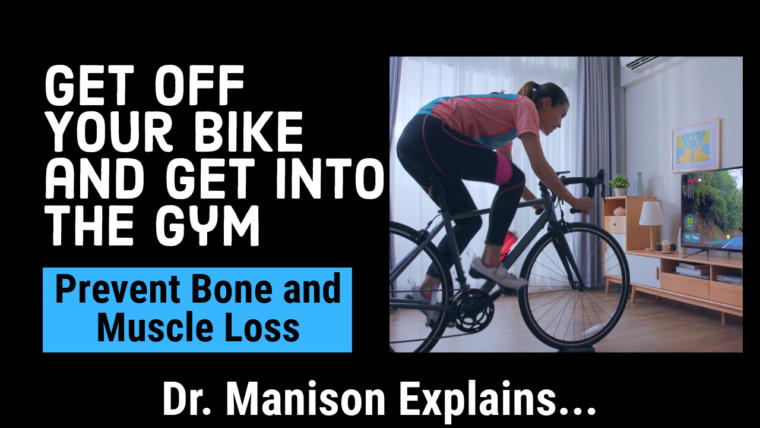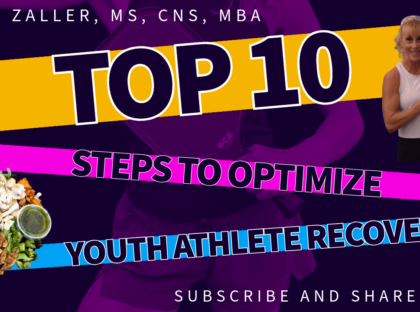You don’t have to stop cycling, but you may need to seriously reduce the amount of time you’re spending on your bike…unless you want to be osteoporotic and sarcopenic. This affects everyone.
When we hear about bone (osteopenia/porosis) and muscle loss (sarcopenia), we tend to think about elderly frail people, not active and fit cyclists. The problem is that avid cyclists are EXTREMELY prone to both muscle and bone loss. It’s highly likely you need to do something about it before it becomes a serious health concern. The good thing is that a lot can be done before the damage is significant but the time to act is now. If you think this doesn’t apply to you, perhaps you are right if you cycle a couple days a week. However, if you cycling many days a week, your risk is greatly elevated. In other words, if you’re on your bike for around 20 hours a week, it’s time to get off and do something else.

Loss of bone quality is significant with cyclists. We can do a lot to prevent this.
How is it possible that such ‘fit’ and active people can get loss of muscle and quality of bone, regardless of age? After all, isn’t exercise good for us? Don’t we build stronger bones and more muscle with lots of activity? Isn’t cycling considered a good activity?
Let’s talk about that. The majority of cyclists used to bike outdoors and with less frequency. But, with the creation of Zwift and other indoor programs, it’s now easy for people to sit on a bike in their basement or garage for hours at a time, almost every day, and just pedal away. Ouch! This is simply over-training and it’s never good. We know that pro cyclists suffer from bone loss and muscle loss, but now we can all throw ourselves into this same realm and this is certainly not good!. The problem tends to also be worse for women than for men, although some sources say the damage is comparable. Also, the older we get, the worse it gets! Yikes!
The amount of training anyone can put in now virtually matches or exceeds what only the higher level amateur and pro cyclists used to be able to perform in the past. There are fewer barriers to over-training. Sure, the end competitive results of riding/racing may not be the same for those just pedaling away in their basement/garage, but the time on the bike and the damage it causes can be the same. Cycling for 99% of people is non-weightbearing and considered an open-chain activity, so, no, there is no true muscular resistance and bone involvement that you need. Don’t try to compare strength training to cycling up a hill. They are not the same thing.
Even for the 1275 pro cyclists worldwide and several thousand more high level amateur cyclists, there is not enough of a pure resistance component to cover all the bases. If there were, competitive cyclists wouldn’t be suffering with such muscle and bone loss. Certainly, if the most competitive and well-trained cyclists are suffering from bone and muscle loss, those who are training too much will certainly suffer the same fate. We all need resistance training for optimal health. This is especially the case as we age. Facts are facts and we need to pay attention. Ever try plyometrics? If not, it’s time. Find a great Functional Movement trainer and get going!
The truth is that not all exercise is good. Too much exercise is detrimental. And to top all that off, too many people cycle too much. We’ve all heard of rhabdomyolysis in the cycling community and the detrimental effects of cycling go far beyond this. So, what is considered to be too much exercise/cycling you might ask? This has an easy answer. Too much exercise is determined by objective criteria that establishes recovery.
If you are cycling multiple days a week (like more than 3) and train often times in heart rate zones 4 and 5, you’re going to waste away. We have to remember that zone 4 and 5 training burns protein after carbohydrate stores are depleted. No fat is burned. Training needs to occur in zone 2, primarily, for health benefits. We also need adequate recovery. Nobody is getting this if they are biking too much.
Data such as temperature changes, heart rate, respiration, and HRV are the 4 cardinal signs that determine your recovery. I’d argue that HRV is the over-riding indicator as it is the only one that directly assesses autonomic nervous system function. With poor HRV, you are sympathetic dominant, and this one very important reason as to why your body wears out quickly. The bottom line is that if you are not recovering well, going out and training hard day after day is the best way to wear your body out and create damage. As we like to say around here, Don’t Be a Meathead!

Cycling leads to muscle loss. We need to pay attention to this!
Let’s look at another factor: nutrition. Most cyclists do not eat the food they need to consume for optimal health. Calories are a big part of holding weight and having enough energy, true, but all too many cyclists try to be light to help their power and although this is good for cycling, it’s not necessarily good for their health. In addition, protein needs are usually never met and this will most definitely lead to injury as muscles cannot heal without adequate protein. You want to be a vegan. Fine. You need 30-100% more protein than the rest of us as the vegan diet tends to lack the essential amino acid Leucine. We need about 2.5gm of leucine per meal to create muscle protein synthesis.
There are three good reasons as to why people are cycling too much. 1. They don’t know what they’re doing. 2. They suffer from Orthorexia, exercise bulimia, and/or exercise addiction. 3. They simply refuse to look at the facts until they have their own health issues. Each of these 3 have their own issues but the second one is a justification of an eating disorder and those people should be seeking professional help. As far as the other two, well, learn what you’re doing to your body and find some other exercise to balance out the damage you are doing. You can ignore the data but you won’t be able to ignore your body when it fails you.
The systemic acidity in your body from overtraining necessitates blood pH regulation by draining calcium from your bones and nobody can say this is a good thing. Another way of looking at this is that excessive exercise increases systemic inflammation. For those who say ‘well, the pH of the blood is always 7.4’, the response to this is ‘sure, it has to be or we die. However, to keep it at 7.4, we need to pull calcium off the bone to neutralize the acidity or the pH will continue to drop lower.’
If you really want to see if you’re acidic or not, test your urine. This is a far better indicator for systemic acidity. (You should be peeing about a 7-8 pH). Let’s face it, if we do not allow for ample recovery time and proper nutrition, we’re going to be catabolic. This means, we are keeping our body in a state of breaking down and this reduces muscle and bone. The studies on cyclists (see several above) are quite clear.
There is another issue we have to consider with cyclists. There is no strength training component with cycling that is necessary for proper musculoskeletal health. This is especially the case with upper body strength but even with lower body strengthening, it’s lacking. Many will say that heavy sprints and climbs cover this, but no, they’re not the same. When you’re pedaling non-stop for long periods of time, whether you use a lot of resistance or not, it’s not the same as power or strength training in a gym with considerate resistance for only a few repetitions.
We can definitely put cycling in the category of endurance and cardiovascular work, but it’s not going to build muscle that we need. As the studies clearly show, cyclists lose muscle mass, they do not tend to gain in. We need to counter this for overall health. We do need some creatine phosphate pump training!
I think we can all agree that being hunched over a bike for hours at a time, several days (or more) a week, is not ideal for postural patterns, upper body strength, and spinal health. It’s simply not good for us.
So, where does all this lead us? What is the solution?
- Be realistic with your cycling goals and time spent on the bike. Biking should be part of a comprehensive exercise program. It should not be the only activity you take part in. Like any single activity, you can over-train and this is never good. Allow your body time to properly recover. If you don’t monitor your recovery, an Oura ring is a perfect way to go. Training without proper recovery leads to a catabolic state that allows for leaching of calcium from your bones to neutralize the acidity from the toxic state of over-training.
- Feed your body properly. I recommend the ISSN guidelines but at least be sure to eat ample protein as it’s needed for muscle health and every enzymatic process in your body. Too many eat to ride, but don’t eat to recover. Recovery is king. You don’t want to lose muscle mass. Eat adequate protein.
- Get off your bike. Really! Get off your bike and get into the gym. Work with a trainer (preferably FMS) and build mobility, stability, and strength all over your body, not just your legs. There is life off the bike. Discover it. Strength training will help your cycling and every other facet of your health. No excuses. Go to it!
I hope this blog has shed some light on some of the injury and health concerns of cycling. Cycling in moderation is the key and blending cycling with other activities is far better for your health than just biking.
Don’t Be a Meathead is protected by Copyright laws. If you wish to post any content from www.dontbeameathead.com, you must obtain express (written…this can be email) permission before doing so. We love sharing important information to help people and we do appreciate your respect for our intellectual property.





